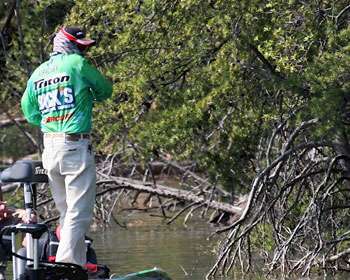
Football, they say, is a game of inches. The same can be said of bass fishing, in which the strike zone of a stubborn bass might boil down to an inch or two. If you get inside the zone, the result is often a bite. Miss it by a little, and you might as well have missed it by a mile.
Elite Series pro Shaw Grigsby points out that one way to overcome a smaller-than-normal strike zone is to make multiple casts to the same piece of cover. "When I started out, I was always fishing kind of slow to begin with," he says. "It was easy for me to find a piece of cover and pitch and pitch and pitch and finally get a bite.
"In doing so, I began to realize that there really is something to what we call 'dissecting cover.' "
Shaw points out that to properly dissect a piece of cover, angles are everything. "A lot of times you can make multiple presentations to a particular piece of cover and never get a bite, only to turn around and pitch to it from a different angle and immediately get bit," the Florida pro explains. "The fish will tell you most of the time how they want the bait presented."
Grigsby explains that in high-pressure situations, bass are most often not going to "go out of their way" to feed. As such, he believes that if a piece of cover looks good, it usually is. "Many times, you can miss the strike zone by 2 inches and never know a bass was there," he says.
"If you pitch one or two times, unless you just get lucky and hit it right the first time, chances are you won't get a bite. If the piece of cover looks like it should hold a fish, keep pitching to it. You just have to throw at it enough times to find the right angle, or dial into its strike zone to get it to react."
Aside from high-pressure, bass will also tighten up in muddy-water situations — such as Shaw found himself in recently at the River Rumble in Iowa. "The muddier the water — like it was in Iowa — the more you have to pitch it into cover," he says.
"In that deal, I would take a stump and hit it two or three times from one corner, and then move around and hit the other corner. It was one of those things where you really had to work hard for each of your strikes."
Mental toughness and the confidence in knowing that you're around fish are two traits that Grigsby points to as being critical in dissecting cover properly. "I fished a beautiful log, and really fished it good, but never got a keeper from it," he says. "Another angler came along right behind me and caught a keeper off it.
"So the moral to the story is that you really have to work it hard — sometimes four or more casts to the same exact spot. A lot of that is me just knowing that there should be something there holding fish."
In making multiple casts, Shaw explains that oftentimes a slight change in bait, or even color, might trigger a response. "You can even fish the same bait a little slower — almost a deadsticking type of deal and wind up getting a bite," he says. "Then other times, it's as simple as just changing from, say, a craw worm to a big paddletail worm that'll make the difference."
Grigsby advises the weekend angler to simply slow down and look at each piece of cover as one that is a potential ambush zone for a bass. "If you've got some cover that should hold a fish or two, just slow down," he says. "By doing so, more often than not you'll pick them apart."
(Provided by Z3 Media)




